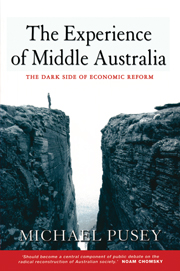Book contents
- Frontmatter
- Contents
- List of Illustrations
- Preface
- Abbreviations
- Chapter 1 The Experience of Economic Reform
- Chapter 2 Incomes and Their Meanings
- Chapter 3 Jobs, Work and Fairness in the Wake of Labour Market Reform
- Chapter 4 Working Families: Struggling with the Costs of Reform
- Chapter 5 Civil Society and Communities
- Chapter 6 Politics, Power and Institutions
- Chapter 7 Judgements on Economic Reform
- Appendix A Chronology of Economic Reform
- Appendix B Methods and Procedures: Middle Australia Project
- Appendix C Supplementary Tables
- Appendix D Income and Equivalent Household Income
- Notes
- Index
Chapter 3 - Jobs, Work and Fairness in the Wake of Labour Market Reform
Published online by Cambridge University Press: 22 September 2009
- Frontmatter
- Contents
- List of Illustrations
- Preface
- Abbreviations
- Chapter 1 The Experience of Economic Reform
- Chapter 2 Incomes and Their Meanings
- Chapter 3 Jobs, Work and Fairness in the Wake of Labour Market Reform
- Chapter 4 Working Families: Struggling with the Costs of Reform
- Chapter 5 Civil Society and Communities
- Chapter 6 Politics, Power and Institutions
- Chapter 7 Judgements on Economic Reform
- Appendix A Chronology of Economic Reform
- Appendix B Methods and Procedures: Middle Australia Project
- Appendix C Supplementary Tables
- Appendix D Income and Equivalent Household Income
- Notes
- Index
Summary
The number of workers in search of employment is not the result of calculations about the ‘saleability’ of available labour power in the market; there is no supply function of labour power that could be determined on the basis of the utility calculations of workers alone; workers do not have the option not to sell their labour power, and neither do they have the option of living on an income that results from a market-clearing price.
Claus OffeOver the last twenty years economic reform has brought two transforming changes to jobs and working life in Australia. Besides the fact that the process is everywhere driven by corporations, one aspect of this transformation is common to other nations that have taken a similar course, while the other is much less so.
The aspect that we share with other similar, would-be ‘advanced’, First World economies sits comfortably enough under the rubric of ‘globalisation’. In this respect economic reform means, everywhere, a top-down process of ‘structural reform’ that is aimed at maximising economic efficiency and productivity. The criteria for what counts as economic efficiency are as clear as they are partial.
- Type
- Chapter
- Information
- The Experience of Middle AustraliaThe Dark Side of Economic Reform, pp. 47 - 75Publisher: Cambridge University PressPrint publication year: 2003



